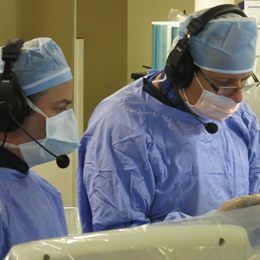 For the first time in Ontario and only the second time in Canada, physicians performed a clinical angioplasty using a stent that completely dissolves over time.
For the first time in Ontario and only the second time in Canada, physicians performed a clinical angioplasty using a stent that completely dissolves over time.
A team in Peter Munk Cardiac Centre’s cardiac catheterization lab inserted the stent as they repaired the narrow artery of a patient with angina.
"This new stent may turn out to be better for patients because there’s no metal," says Dr. Vlad Dzavik, deputy head, Division of Cardiology and Director of Interventional Cardiology Research, University Health Network. “And a stent that is not there for a patient's lifetime might be especially useful in younger patients.”
Traditional stents are made of metal, which can complicate bypass surgery if the patient needs that in the future.
“This scaffold repairs the damage and dissolves within two years, leaving no foreign material in the body,” says Dr. Dzavik.
This bioabsorbable stent, a polymer made from lactic acid, provides the structural support needed in the artery during and immediately following angioplasty. It is also coated with drugs that help the artery heal without abnormal tissue build-up after the procedure.
Dr. Dzavik is quick to point out that this does not make metal stents obsolete.
"Metal stents can save the life of a patient having a heart attack and can stop the angina of a patient with more chronic symptoms. But they can also make blood vessels behave abnormally," adds Dzavik. "The vessel might contract when it shouldn’t and could decrease blood flow into the heart."
The stent used is the only bioabsorbable stent available for clinical use right now and is currently only available by special access from Health Canada.
Researchers want to learn more about this stent so that they can better understand which patients might benefit most from having this kind of a scaffold inserted.
« Back to Innovation Gallery
